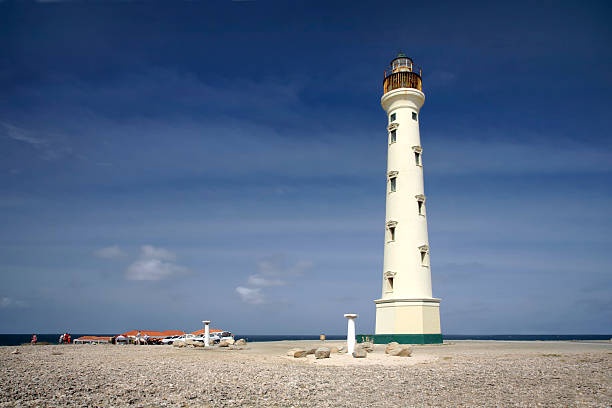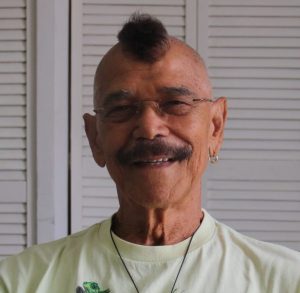
(Oranjestad)—At the furthest western point of the island, there lies the tallest structure on the island: The California Light House. Standing on top of a limestone cliff, this lighthouse oversees the entire island, offering one of few best views of the island and the surrounding sea. It is also one of the few monuments that hold a rich history.

The lighthouse was constructed in between 1914-1916, and its first keeper was a young trained lighthouse keeper from Curacao names Jacob Jacobs. Mr. Frederico Fingal was the last man to have occupied this position until 1962. Though his son, Mr. Romulo Fingal did not continue in his father’s footsteps, he does have a special connection to the lighthouse. He sat down with our reporter and shared a bit of its history.
As Mr. Fingal explains, “In 1915, cargo donkeys were hired from Figaroa di Noord to help build the Lighthouse at Westpunt. The donkeys had to walk along the beach all the way to Westpunt carrying the cargo, poles, cement, and all these things. At that time, it was a difficult task until Aruba got its first truck. These things reflect how people could have accomplished this tremendous job with so little.” Mr. Fingal said, “At that time, it wasn’t a place for people to work. It was very challenging because it was full of goats and donkeys, and it was very isolated. There were no hotels or roads to get there. There was only a donkey trail. Those were the only means of transportation.”
Mr. Fingal continues, “In 1939, I was born in the lighthouse, and my father was the last lighthouse keeper until he retired in 1962. After that, they removed the power cables all the way to the top. According to the story, we couldn’t have the light ourselves because they dismantled it, and after many years, I heard that it is in a train museum in San Nicolas, where we found this very special lens that, when the light shines through it, it reaches 30 kilometers out to sea.” Mr. Fingal told our reporter.
The lighthouse has a long and very interesting history. The reason why the lighthouse was built, according to Mr. Fingal, dates back to the day when the cargo ship S.S. California sank because of the lack of light. In 1913, Aruba made a request to Curacao to build a Lighthouse at Westpunt, and the governor of Curacao responded to Aruba to come back in 1915 with a well-detailed plan. “During the First World War from 1914 to 1918, they had to wait for the light to be transported to Aruba because it was manufactured in France. At that time, there was no electricity, and the light was very interesting because it rotated with a kerosene lamp that planes used; clean kerosene,” Mr. Fingal said.
Mr. Fingal discovered something very interesting about the lighthouse after much research was documented in his book ‘History of the Lighthouse at Westpunt.’ He found many details: “I found out that the height of the lighthouse was due to the absence of electricity. There was also the presence of coral. There is a long steel cable from where the light is, and under the light, at the highest point, there is a hanging weight, a sort of pendulum that swings like that, with a weight that measures about 1 meter by 30 centimeters wide, which is a block of solid iron attached to a cable. When you release it upwards, it comes down, and the weight that comes down pulls it up, gradually. And while it comes down, the same weight that is descending causes many small wheels to turn in the opposite direction. The Lighthouse rotates from 6 pm in the evening, when the sun sets, until 6 am in the morning. During the entire night, the light shines on the lantern, it goes down 24 meters, and the Lighthouse is 30 meters high. It is designed not to collapse,” Mr. Fingal explains.
Mr. Fingal further explains that in one night, the lighthouse rotates 4,320 times and consumes one gallon of kerosene for the whole operation. “At that time, the kerosene was supplied from the Lago refinery. Every day it was brought down, and to start the light again, they had to lift the weight up, so our job as children was to crank it and raise the weight back up in the evening when the light stuck, they would take it down again, and the light stayed down. That’s how it worked for a very long time,” Mr. Fingal explains.
Thanks to the Monument Fund Aruba, which worked hard and is currently in charge of the Lighthouse, Mr. Fingal is very happy with its preservation, along with all the renovations that have taken place. He hopes that the story of the lighthouse will continue to live on for future generations.



















